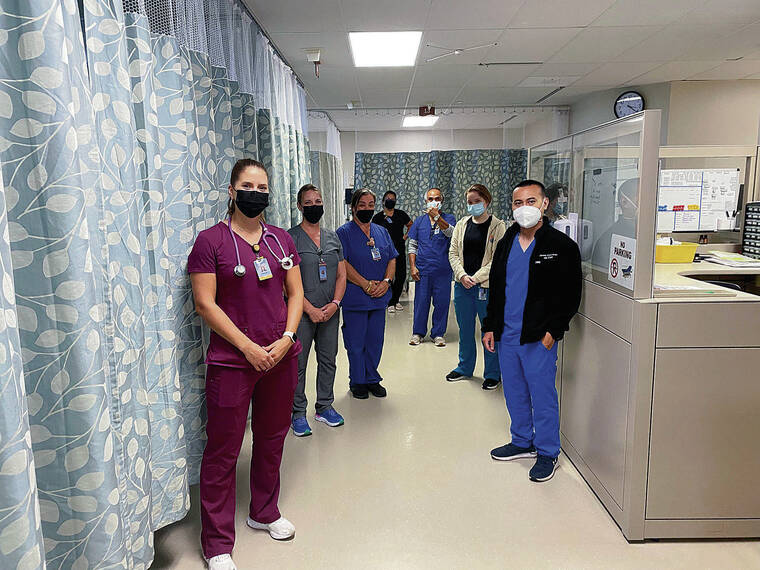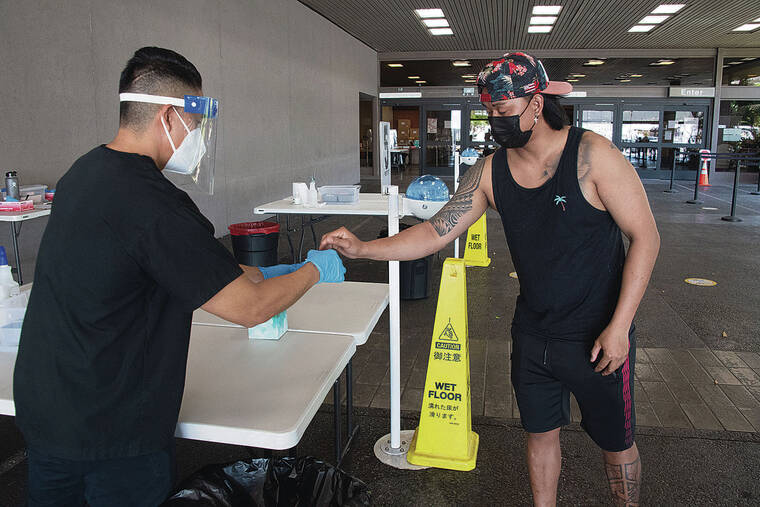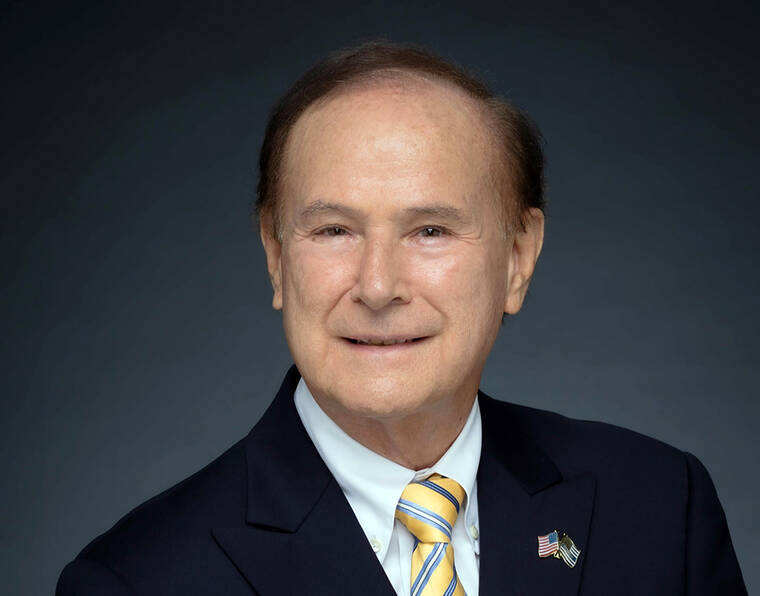Hawaii hospitals still at full capacity despite declining COVID-19 case counts

COURTESY HILO MEDICAL CENTER
Health care workers gathered in the short-stay overflow area of Hilo Medical Center, which has been operating at overcapacity for several weeks.

CRAIG T. KOJIMA / CKOJIMA@STARADVERTISER.COM
Chris Ramos, left, gave a swab to a client for COVID-19 testing Wednesday at Daniel K. Inouye International Airport. Testing is available daily from 9 a.m. to 5 p.m.


Hawaii hospitals are still struggling with staffing shortages even as the daily average of COVID-19 case counts appears to be on its way down.
Hospitals statewide are at full or overflowing capacity, as has been the case for the past few months — even without an influx of COVID-19 patients, according to the Healthcare Association of Hawaii.
“The hospitals continue to be very, very busy,” said Hilton Raethel, president and CEO of HAH, noting an average of 2,410 patients a day over the past week. “What’s critical for us is not the number of COVID patients, but the total number of patients. It’s that total census number that is continuing to stay high.”
This means patients are on hold in emergency rooms, waiting for inpatient beds, while still others are waiting to be seen in the emergency department.
Staffing shortages also continue, with approximately 900 to 1,000 front-line health care workers out on any given day, according to Raethel.
In late July, HAH asked Gov. David Ige to issue an emergency proclamation waiving state licensing requirements for out-of-state health care workers to alleviate the situation. Although hospitals are bringing in mainland workers to help, the state agency issuing their licenses is itself short-staffed, resulting in delays.
Don't miss out on what's happening!
Stay in touch with breaking news, as it happens, conveniently in your email inbox. It's FREE!
Raethel said the state was working on emergency rules instead of a proclamation that would allow out-of-state workers with current, unencumbered licenses to work in Hawaii during a 120-day period.
“We are anxiously awaiting these rules because we do need to bring in staff faster than we’re able to get them right now,” he said.
Hawaii’s COVID-19 trends, meanwhile, offer hope of some respite this summer.
The Hawaii Department of Health on Wednesday reported the state’s seven-day average of new cases fell to 452, down from 528 reported Aug. 3 — marking a decline for three consecutive weeks. It is about half of the daily average reported a month ago.
Actual numbers are estimated to be at least five to six times higher since these figures do not include home test kit results.
There is, however, a self-reporting feature Opens in a new tab offered by the state’s AlohaSafe Alert app that allows users to report positive home tests. From early May to early August, nearly 3,700 self-report codes have been issued. Since May 7 the feature has been used daily.
The state’s average positivity rate, meanwhile, continued its downward trend to 12.4%, compared with 13.8% reported the previous week.
There were 142 patients with COVID-19 infection in Hawaii hospitals Wednesday, according to HAH, with 11 in intensive care. Over the past week, an average of 141 COVID-19 patients were hospitalized per day, with an average of 23 new COVID-19 admissions per day — lower than in late July.
Tim Brown, infectious disease expert at East-West Center in Manoa, said, “This week’s data implies we are now in a slow descent in both cases and positivity from the plateau we were sitting on a month earlier.”
He added, “This still leaves fairly high levels of community transmission, which continues to challenge our health care system through COVID-related absences of critical staff, even though COVID-related hospitalizations are declining slowly.” At this time, Brown said, “individuals should continue to take precautions, especially to protect the more vulnerable in their communities, workplaces and families.”
Hilo Medical Center has been operating at overcapacity for several weeks, according to spokesperson Elena Cabatu, requiring it to open up overflow areas in other areas, including its obstetrics unit and extended care, short-stay and recovery facilities.
On Wednesday, Cabatu said there continued to be a “high census situation,” with five holds in the emergency department, 13 patients in overflow areas and 33 others waiting for discharge to the next level of care.
This is not due solely to a high number of COVID-19 patients, but “a continuous flow of sicker patients seeking care for a variety of issues, including COVID,” she said. Also, because long-term care facilities, also strapped by staffing shortages, are limiting admissions.
Staff are still working overtime, even with help from traveling health care workers and a paid nurse aide training program.
“The first half of this year we exceeded the total amount of trauma cases in East Hawaii than all of last year,” Cabatu said. “So that has also kept our emergency department busy.”
Novavax available
The DOH, meanwhile, announced Wednesday that the Novavax COVID-19 vaccine is now available in Hawaii.
Novavax is a two-dose primary series vaccine for people age 18 and older. It might be well suited for those who prefer a more traditional kind of vaccine or who are allergic to an ingredient in the mRNA vaccines manufactured by Pfizer or Moderna, according to health officials.
The U.S. Centers for Disease Control and Prevention recommended the Novavax vaccine — a protein subunit vaccine — as a new option in July following federal approvals.
It includes harmless proteins of the COVID-19 virus that trigger an immune response, according to the DOH, similar to the way other protein subunit vaccines have been used for hepatitis B in the United States for more than 30 years.
Novavax is currently available at the 5 Minute Pharmacy in Waipahu on Oahu, and is listed as available at the Safeway Pharmacy in Kailua-Kona on Hawaii island.
Kaiser Permanente also is accepting appointments from members and nonmembers for Novavax vaccines in all counties. The health care provider is slated to begin administering shots Monday. Appointments are required by calling 808-432-2000.
DOH said Novavax was distributed to providers who expressed an interest, and that locations will be listed as they become available on the vaccine locator map at hawaiicovid19.com/vaccine Opens in a new tab.
As of Wednesday, 77.1% of the state’s population had completed their primary series of shots, with about 45% boosted once and 11% boosted twice.
An estimated 325,000 eligible residents in Hawaii still remain unvaccinated.




